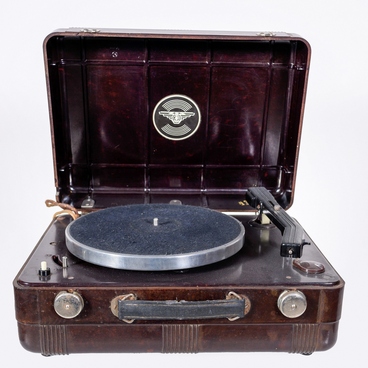Polyphon was a mechanical device capable of playing melodies, reminiscent of a music box and a gramophone at the same time. Its name comes from the Greek word “polyphony”, which means “many sounds”. The German company “Polyphon Musikwerke” produced the first polyphon in the early 1890s. Soon such devices were mass-produced. They were popular all over the world until the 1900s when gramophones and pathephones replaced them.
The polyphon from the collection of the National Museum of the Republic of Mari El belonged to a timber merchant named Zykov, who lived in Tsarevokokshaysk, now the city of Yoshkar-Ola. The musical mechanism is placed in a case with metal handles; it is lined with veneer — a thin layer of expensive wood. It is impossible to establish the exact type of wood now, but historians suppose that it could be oak, ash, maple, or boxwood. The corners of the case are decorated with ornamental carvings.
There used to be a special drawer for disks in the lower part of the case, however, it has not survived to this day. The discs were flat perforated metal plates. Inside the case, there was a shaft with pins, which was driven by a winding mechanism. When the pins hit the holes in the disk, they produced a melodic sound, and a certain sequence of such coincidences created a recognizable motif.
The polyphon from the collection of the National Museum of the Republic of Mari El was made in the late 19th or early 20th century, by one of the oldest firms in Switzerland — “Mermod Freres”. It was founded by the brothers Gustave-Alfred, Louis-Philippe, Charles-Philippe, and Edmond-Justin Mermode in 1816. During the 19th century, the company became one of the most known manufacturers of famous Swiss watches. Then the company expanded its range and began to produce mechanical musical devices, including polyphons. However, with Germany soon providing competition in polyphon production, the sales of Swiss devices gradually declined.
In the Russian Empire, polyphons were popular in the late 19th and early 20th centuries. They were commonly known as music boxes and were later replaced by gramophones and pathephones.
The polyphon from the collection of the National Museum of the Republic of Mari El belonged to a timber merchant named Zykov, who lived in Tsarevokokshaysk, now the city of Yoshkar-Ola. The musical mechanism is placed in a case with metal handles; it is lined with veneer — a thin layer of expensive wood. It is impossible to establish the exact type of wood now, but historians suppose that it could be oak, ash, maple, or boxwood. The corners of the case are decorated with ornamental carvings.
There used to be a special drawer for disks in the lower part of the case, however, it has not survived to this day. The discs were flat perforated metal plates. Inside the case, there was a shaft with pins, which was driven by a winding mechanism. When the pins hit the holes in the disk, they produced a melodic sound, and a certain sequence of such coincidences created a recognizable motif.
The polyphon from the collection of the National Museum of the Republic of Mari El was made in the late 19th or early 20th century, by one of the oldest firms in Switzerland — “Mermod Freres”. It was founded by the brothers Gustave-Alfred, Louis-Philippe, Charles-Philippe, and Edmond-Justin Mermode in 1816. During the 19th century, the company became one of the most known manufacturers of famous Swiss watches. Then the company expanded its range and began to produce mechanical musical devices, including polyphons. However, with Germany soon providing competition in polyphon production, the sales of Swiss devices gradually declined.
In the Russian Empire, polyphons were popular in the late 19th and early 20th centuries. They were commonly known as music boxes and were later replaced by gramophones and pathephones.



